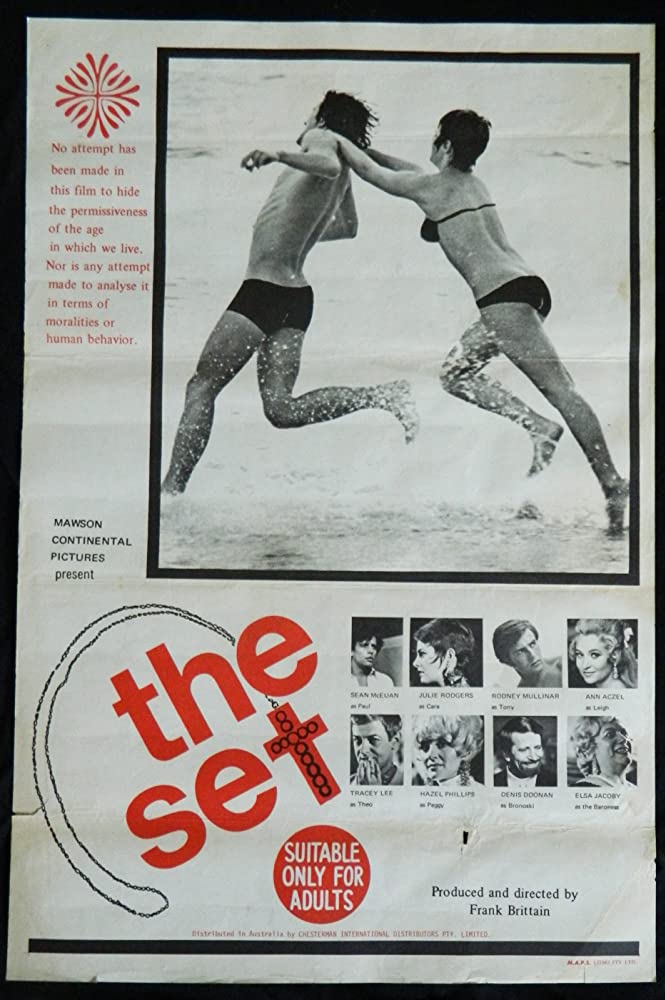

Set, The (Frank Brittain, 1970) novel by Roger Ward; Sean Myers, Rod Mullinar; two young men have an affair; one attempts suicide; overseas sale banned by the censor
Australia’s first queer movie set to make a comeback
Stephen A. Russell, SBS, 8 December 2017
Nearly five decades later, The Set is being released for a whole new generation to enjoy.
Dubbed Australia’s first gay film, racy sexploitation drama The Set will be released on DVD and VOD almost 50 years after its initial cinematic run in 1970.
Due to be distributed by Bounty Films in March next year, the film’s original trailer was in honour of marriage equality legislation passing parliament.
It stars Sean Myers as Paul, a young department store clerk in Sydney who finds a creative escape working as a set designer for theatre luminary and socialite Marie (Brenda Senders). Rejecting her sexual advances, Paul instead winds up falling into bed with rich boy Tony (Rod Mullinar).
Written by Mad Max star and prolific theatre actor Roger Ward, The Set was originally conceived as a novel and is loosely based on his observance of Adelaide’s theatre scene, where he began acting as a 12-year-old.
“It caused a bit of a stir,” Ward says of his original manuscript. “I tried to flog it to various publishing houses and they wouldn’t wear it. They were quite disgusted with the homosexual content, and I was thrown out of various offices”
Actor friend Ed Devereaux put Ward in touch with Frank Brittain, who had produced Devereaux’s last movie, Journey Out of Darkness. Brittain and his wife, Diane, were immediately taken with the story and leapt on the unpublished manuscript, adapting it for the big screen alongside Ward and Ken Johnson.
“Frank wanted me to lift out every homosexual angle in the book, but I said, ‘I just can’t do that, Frank. It’s like cutting the arms or legs off of my baby.’ But he said, ‘Give me the bloody manuscript,’ and he grabbed it from me and put a big bloody line through every page.”
Shot on an extremely low budget by first-time director Brittain, with very few takes, the rough and ready movie was nonetheless a big hit with contemporary audiences hungry for a cinematic representation of the more sexually liberated world they were witnessing first hand.
“It was a box office success,” Ward says. “It was controversial and people were lining up for three or four blocks and it was on for many weeks. I did the PR for it, and I was an arrogant young bastard. I said, ‘This will create box office records, it will win a prize at Cannes,’ and I carried on and thumped the table.”
Ward’s glad to see The Set reassessed as a film of historical value. “When young gay and lesbian people see it now, they just love it. ‘My God,’ they ask, ‘were gay people treated like that in those days?’”
Lisa Daniel, former artistic director of the Melbourne Queer Film Festival, hosted a retrospective screening of The Set during her time at the head of Australia’s longest running showcase of LGBTIQ cinema.
“The Set is a ripper,” Daniel said. “It’s a classic representation of the camp 1970s Australian subculture, with standout performances by Rod Mullinar and Sean Myers.”
Daniel added that The Set gaining a VOD/DVD release was important for the bigger picture of preserving queer cinema in Australia. “It’s fantastic that film lovers are gaining access to such a pivotal and often forgotten Australian film. Too often these artworks are lost to us, but in this case commonsense has prevailed.”
Former MQFF board member Paul Clifton agrees, “Filmmakers and audiences need to see our history, which in Australian films especially, and gay films in particular, is too often forgotten.”
Referring to the early depiction of male bisexuality on screen, Clifton notes it is not quite as surprising as it might at first appear. “I think the conservatism of later years masks the fact that the '60s and '70s were a massively progressive time that puts us to shame today.”
Leslie Morris, marketing manager at Bounty Films, said The Set was an important film that deserved to live on. “It was the first film to challenge traditional notions of sexuality and to depict a progressive, modern Australia.
“It was also the first locally produced film to have sex scenes, show graphic nudity and, most importantly, show normal people being in a totally ordinary same-sex relationship,” Morris added. “1970 wasn't ready for The Set, but we are now.”
Garry Gillard | New: 16 December, 2017 | Now: 28 June, 2020